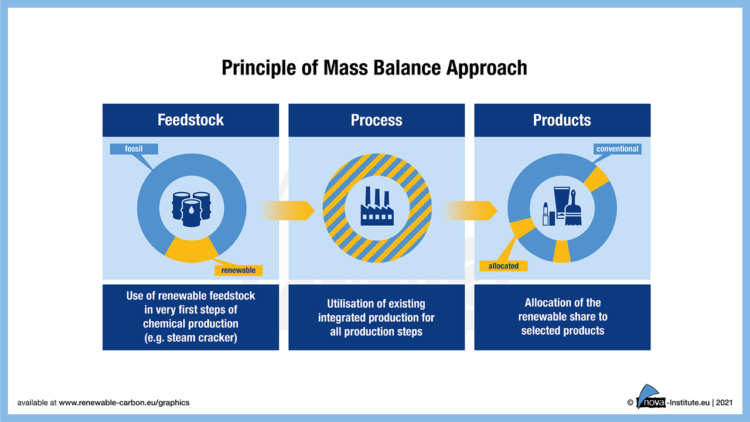A Closer Look at Mass Balance Approach
- 1 What is the Mass Balance Approach?
- 2 Real-World Example: Hybrid Vehicles
- 3 Benefits of the Mass Balance Approach
- 4 How to Implement the Mass Balance Approach
- 4.1 1. Identify the Chain of Custody Model
- 4.2 2. Select a Certification Scheme
- 4.3 3. Create a Reliable Bookkeeping System
- 4.4 4. Find a Certification Body
- 4.5 5. Develop a Practical Implementation Timeline
- 5 Overcoming Challenges
- 6 Success Stories
- 7 The Future of the Mass Balance Approach
- 8 Conclusion
The world is gradually transitioning towards sustainability by adopting more eco-friendly products and reducing the consumption of fossil resources. Innovative solutions across various industries are moving away from traditional methods of sourcing raw materials. However, achieving a complete shift to sustainability can be challenging. This is where the mass balance approach comes in, offering a practical method to move towards a climate-neutral circular economy. This approach provides a way to maintain both quality and sustainability, making it a valuable tool for businesses and consumers alike.
In this blog, we will take a closer look at the mass balance approach to understand what it is and how it can help us build a greener and more sustainable future. Let’s begin:
What is the Mass Balance Approach?
The mass balance approach is a method based on the principle of conservation of mass, which states that the total amount of mass in a system must remain constant over time. It is often used in fields like environmental science, chemical engineering, and geology to study the distribution, transport, and transformation of various substances in the environment.
In terms of sustainability, this method allows for the reduction of fossil raw materials by replacing them with sustainable materials. Essentially, it enables industries to use a mix of traditional and renewable feedstocks within the same production system, gradually increasing the proportion of sustainable materials without the need for separate production lines.
Real-World Example: Hybrid Vehicles
To better understand the mass balance approach, consider the example of hybrid vehicles. Unlike electric cars, hybrid vehicles run on both fossil fuels and electricity. While they are not completely pollution-free, they are more environmentally friendly compared to cars powered solely by diesel or petrol. The mass balance approach works on a similar principle. It helps businesses in the chemicals and plastics industry incrementally transition to using sustainable feedstocks while maintaining the quality and functionality of their products.
Benefits of the Mass Balance Approach
Conserves Fossil Fuels
The mass balance approach helps businesses meet sustainability goals by reducing the use of fossil fuels while maintaining product quality. This not only conserves non-renewable fossil fuels but also demonstrates a commitment to a healthier planet.
Offers a Practical Transition
A complete transition to sustainability often requires significant capital investment, changes in infrastructure, and team training. However, by adopting the mass balance approach, industries can integrate sustainable products into their existing production systems without incurring excessive costs or time delays.
Versatile in Use
The mass balance approach is versatile and can be applied across different industries and products. Whether it’s a plastic manufacturing company or an electronics brand, the mass balance approach helps bridge the gap to sustainability in a shorter time frame.
Easy to Track
One of the key advantages of the mass balance approach is its transparent bookkeeping. A mass balance system maintains a record of the chain of custody, material composition, and production processes. This system is often certified by third-party organizations, making it easier to track and measure sustainability efforts.
How to Implement the Mass Balance Approach
Here is a step-by-step guide for businesses looking to adopt the mass balance approach:
1. Identify the Chain of Custody Model
The first step is to identify the appropriate chain of custody model for your market and business operations. The chain of custody refers to the documented and unbroken trail of materials as they move through the supply chain. There are different models, such as segregated, mass balance, and book and claim, each with its own set of requirements and advantages.
2. Select a Certification Scheme
Next, select a certification scheme based on your business needs, market demand, scalability, and the standards that need to be met. Certification schemes such as ISCC (International Sustainability and Carbon Certification) or RSPO (Roundtable on Sustainable Palm Oil) provide frameworks for sustainable production and traceability.
3. Create a Reliable Bookkeeping System
Develop a plan or Minimum Viable Product (MVP) for a system that maintains reliable bookkeeping for the certification. This system should track the input and output of materials, ensuring that the amount of sustainable material used is accurately recorded and reported.
4. Find a Certification Body
Identify a certification body that can conduct audits and verify compliance with the chosen certification scheme. This body will review your processes and systems to ensure they meet the required standards.
5. Develop a Practical Implementation Timeline
Finally, create a realistic timeline for implementing the mass balance approach. This timeline should consider the necessary operational changes and auditing steps, ensuring a smooth transition without disrupting business operations.
Overcoming Challenges
While the mass balance approach offers numerous benefits, it also comes with its own set of challenges. One of the primary challenges is ensuring transparency and traceability throughout the supply chain. This requires robust data management systems and cooperation from all stakeholders involved in the production process.
Another challenge is gaining market acceptance. Consumers and businesses need to understand and trust the mass balance approach. Education and communication are crucial in promoting the benefits and reliability of this method.
Success Stories
Several companies have successfully implemented the mass balance approach, setting examples for others to follow. For instance, BASF, a leading chemical company, has adopted the mass balance approach to produce bio-based chemicals. By integrating renewable feedstocks into their existing production processes, BASF has been able to reduce their reliance on fossil fuels and lower their carbon footprint.
Similarly, IKEA has used the mass balance approach to produce more sustainable plastics for their products. By using renewable materials in its supply chain, IKEA has made significant strides toward its goal of becoming a fully circular and climate-positive company by 2030.
The Future of the Mass Balance Approach
The mass balance approach represents a significant step towards a sustainable future. As industries continue to seek ways to reduce their environmental impact, this method offers a practical and scalable solution. With advancements in technology and increased awareness of sustainability issues, the mass balance approach is likely to gain more traction and acceptance in the coming years.
Get Expert Consultation
The mass balance approach is an excellent pathway for industries to transition to sustainability continuously and measurably. However, understanding how to adopt this approach can be complex. Businesses can benefit from expert consultations or detailed reports on the mass balance approach to ensure proper implementation and cost-effectiveness. Experts can provide valuable insights and guidance, helping businesses navigate the challenges and maximize the benefits of this sustainable method.
Conclusion
The mass balance approach is a powerful tool in the journey towards sustainability. Allowing industries to gradually increase the use of renewable materials without overhauling their entire production systems offers a practical and cost-effective solution. With its ability to conserve fossil fuels, provide a versatile application, and ensure transparency, the mass balance approach is paving the way for a greener future. Industries looking to embrace sustainability can greatly benefit from understanding and implementing this approach, ultimately contributing to a healthier planet for future generations.

















